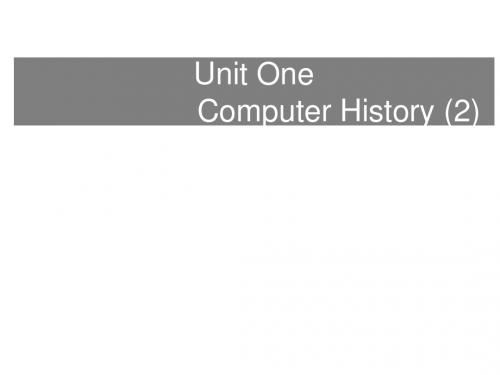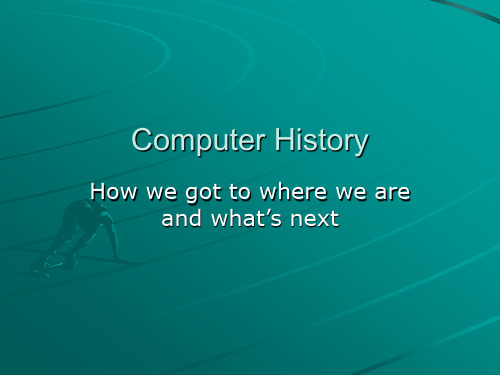Computer History
- 格式:doc
- 大小:25.50 KB
- 文档页数:2

电脑的历史英语作文The history of computers spans centuries, evolving from simple calculating devices to the sophisticated machines we rely on today. Let's take a journey through the key milestones in computer history.The earliest precursor to the modern computer dates back to ancient times with devices like the abacus, usedfor basic arithmetic. However, it wasn't until the 19th century that the concept of a programmable machine began to take shape. Charles Babbage, often regarded as the "father of the computer," designed the Analytical Engine in the 1830s. Although never completed during his lifetime, Babbage's design laid the groundwork for future computing machines.The late 19th and early 20th centuries saw significant advancements in computing technology, particularly with the development of electromechanical machines. One notable example is the tabulating machine invented by HermanHollerith, which played a crucial role in processing data for the 1890 United States Census.The true dawn of the electronic computer age arrived in the mid-20th century with the invention of the ENIAC (Electronic Numerical Integrator and Computer) in 1946. Developed by J. Presper Eckert and John Mauchly at the University of Pennsylvania, ENIAC was the world's first general-purpose electronic digital computer. It weighed over 27 tons and occupied a large room, but itscapabilities were groundbreaking for its time.Following ENIAC, the development of computers progressed rapidly. The UNIVAC (Universal Automatic Computer), introduced in 1951, became the first commercially available computer. It was used for a variety of applications, including business data processing and scientific calculations.The 1950s and 1960s witnessed the emergence of programming languages and operating systems, making computers more accessible to users. FORTRAN, developed byIBM in 1957, was one of the first high-level programming languages, greatly simplifying the process of writing code. In 1964, IBM introduced the System/360 mainframe computer, which set the standard for compatibility across different models and paved the way for modern computing architectures.The 1970s marked the rise of personal computing withthe introduction of the Altair 8800, the first commercially successful microcomputer kit. This era also saw thefounding of companies like Apple and Microsoft, which would play instrumental roles in shaping the future of computing.The 1980s and 1990s brought further innovations, including the development of graphical user interfaces (GUIs) and the proliferation of personal computers in homes and offices. Apple's Macintosh, launched in 1984, popularized the use of GUIs, while Microsoft's Windows operating system became the dominant platform for PC users.The turn of the 21st century ushered in the era of mobile computing and the internet. Devices like smartphones and tablets revolutionized how we interact with technology,enabling constant connectivity and access to information on the go. Cloud computing emerged as a powerful paradigm, allowing users to store and access data remotely over the internet.Today, we stand on the cusp of the next wave of computing innovation, driven by artificial intelligence, quantum computing, and other cutting-edge technologies. The history of computers is a testament to human ingenuity and our relentless pursuit of progress in the digital age. As we look ahead, the possibilities for what computers can achieve seem limitless.。



计算机历史与发展英语作文英文回答:Computer history and development has been a fascinating journey filled with innovation, breakthroughs, and challenges. The evolution of computers can be traced back to the early 20th century when the first mechanical computers were invented. These early machines were large, slow, and mainly used for complex calculations.As time went on, the development of electronic computers revolutionized the industry. The invention of the ENIAC in the 1940s marked a significant milestone in computer history, as it was the first general-purpose electronic computer. This paved the way for the development of smaller, faster, and more powerful computers in the following decades.The introduction of personal computers in the 1970s and 1980s brought computing power to the masses. Companies likeApple and IBM played a crucial role in popularizing personal computers and making them more accessible to the average consumer. This era also saw the rise of operating systems like MS-DOS and Windows, which further simplified the user experience.The advent of the internet in the 1990s changed the way we use computers forever. The World Wide Web made it possible to access information, communicate with others, and conduct business online. This led to the development of e-commerce, social media, and other online services that have become an integral part of our daily lives.Looking ahead, the future of computer technology is filled with exciting possibilities. Advancements inartificial intelligence, quantum computing, and other emerging technologies are shaping the next generation of computers. These innovations have the potential to revolutionize industries, improve efficiency, and enhance our quality of life.In conclusion, the history and development of computershave come a long way since their humble beginnings. From mechanical calculators to supercomputers, computers have transformed the way we work, communicate, and live. As technology continues to evolve, I am excited to see whatthe future holds for the world of computers.中文回答:计算机的历史与发展是一段充满创新、突破和挑战的迷人旅程。


我国计算机发展的历史英文回答:China's computer industry has a rich and dynamic history, spanning over several decades and marked by significant advancements and milestones.Early Beginnings.China's journey in computer science began in the 1950s with the establishment of research institutes and universities dedicated to the field. In 1956, the Institute of Computing Technology (ICT), under the Chinese Academy of Sciences, was founded and became the cradle of China's computer development.1960s and 1970s: Indigenous Development.During the 1960s and 1970s, China embarked on an ambitious program of indigenous computer development,driven by the need for self-reliance. In 1965, the ICT developed the first Chinese-made general-purpose computer, the DJS-10. This was followed by a series of successful projects, including the Dongfeng-11 (DF-11) supercomputer in 1973.1980s: Opening Up and Reform.The economic reforms initiated in the late 1970s brought significant changes to China's computer industry. The opening up of the economy to foreign investment and technology led to the influx of advanced computer systems and software. This period also witnessed the emergence of domestic computer companies, such as Lenovo and Huawei.1990s: Rapid Growth and Internet Boom.The 1990s was a decade of rapid growth for China's computer industry. The widespread adoption of personal computers (PCs) and the rise of the internet fueled the demand for computer hardware and software. Chinese companies seized this opportunity and expanded theiroperations both domestically and internationally.2000s to Present: Innovation and Global Leadership.The 21st century has been marked by China's rise as a global leader in computer technology. Chinese companies, such as Alibaba, Tencent, and Baidu, have emerged as tech giants with significant influence in the global marketplace. China has also made substantial investments in research and development (R&D), driving advancements in areas such as artificial intelligence (AI), cloud computing, and quantum computing.Today, China's computer industry is a vibrant and innovative ecosystem, contributing significantly to the country's economic growth and global competitiveness.中文回答:我国计算机发展的历史。
英语基础名词11类共196个一、课程名称1、语文Chinese2、数学math3、英语English4、科学science5、政治politics6、历史history7、地理geography8、物理physics9、化学chemistry10、生物biography11、计算机computer12、音乐music13、体育PE14、美术art二、时间名称15、星期一Monday16、星期二Tuesday17、星期三Wednesday18、星期四Thursday19、星期五Friday20、星期六Saturday21、星期天Sunday22、一月January23、二月February24、三月March25、四月April26、五月May27、六月June28、七月July29、八月August30、九月September31、十月October32、十一月November33、十二月December34、季节season35、春天spring36、夏天summer37、秋天autumn38、冬天winter三、公共场所名称39、火车站train station40、停车场car park41、超级市场supermarket42、医院hospital43、宾馆hotel44、电影院cinema45、汽车站bus station46、邮局post office47、银行bank48、餐馆restaurant49、书店bookstore50、大学university51、公厕toilet52、图书馆library53、广场square54、酒吧bar55、机场airport56、网吧net bar57、咖啡馆café58、加油站filling station59、高速公路freeway四、果蔬名称60、西红柿tomato61、马铃薯potato62、胡萝卜carrot63、卷心菜cabbage64、洋葱onion65、黄瓜cucumber66、大白菜Chinese leaves67、芹菜celery68、苹果apple69、梨pear70、桃peach71、葡萄grape72、香蕉banana73、菠萝pineapple74、西瓜watermelon75、橙orange76、柠檬lemon77、芒果mango78、草莓strawberry79、油桃nectarine80、樱桃cherry81、花生peanut82、枣date五、运动名称83、篮球basketball84、足球soccer85、乒乓球table tennis86、排球volleyball87、棒球baseball88、游泳swimming89、跳水ping90、自行车cycling91、羽毛球badminton92、拳击boxing93、摔跤wrestling94、射击shooting95、网球tennis96、瑜伽yoga97、慢跑jogging98、散步walk99、高尔夫球golf 100、滑冰skating 101、滑雪skiing 102、冲浪surfing 103、旱冰roller-skating 104、网球tennis105、跳高high jump 106、跳远long jump六、职业、身份名称107、会计accountant108、机修工mechanic109、导游guide110、程序员computer programmer 111、幼儿教师child-care service teacher 112、模特model113、医生doctor114、护士nurse115、警察policeman(policewoman) 116、厨师cook117、门童bell boy118、教授professor119、服务生waiter(waitress)120、士兵soldier121、司机driver122、理发师barber123、出纳cashier124、服务员attendant125、演员actor(actress)126、推销员salesman127、经理manager128、作家writer129、秘书secretary130、总裁CEO131、裁缝tailor七、衣帽、服饰名称132、衣服clothes133、衬衫shirt134、T-恤衫T-shirt135、西服suit136、外套coat137、手套glove138、便帽cap139、长裤pants140、风衣windbreaker 141、连衣裙dress142、裙子skirt143、运动衫、毛衣sweater 144、牛仔裤jeans145、短袜sock146、鞋shoes147、靴子boot148、拖鞋slipper八、日用品名称149、茶杯cup150、牙刷toothbrush 151、牙膏toothpaste 152、毛巾towel153、肥皂soap154、洗发水shampoo 155、木梳comb156、镜子mirror157、雨伞umbrella158、洗衣粉washing power 九、颜色名称159、红red160、黄yellow161、蓝blue162、绿green163、白white164、黑black165、紫purple166、灰gray167、棕brown168、粉红pink169、褐tan十、简单食物、饮品名称170、鸡蛋egg171、牛奶milk172、面包bread173、肉meat174、牛肉beef175、牛排steak176、猪肉pork177、蛋糕cake178、披萨pizza179、沙拉salad180、汉堡包hamburger 181、热狗hot dog 182、可乐coke183、冰淇淋ice cream 184、零食snacks185、三明治sandwich十一、交通工具名称186、公共汽车bus 187、火车train188、轿车car189、计程车taxi 190、地铁subway 191、动车bullet train 192、飞机plane193、轮船ship194、货车truck195、摩托车motor bike 196、自行车bike。
Computer History
Year/Enter Computer History
Inventors/Inventions Computer History
Description of Event
1936 Konrad Zuse - Z1 Computer First freely programmable computer. 1942 John Atanasoff & Clifford Berry
ABC Computer Who was first in the computing biz is not always as easy as ABC.
1944 Howard Aiken & Grace Hopper
Harvard Mark I Computer The Harvard Mark 1 computer.
1946 John Presper Eckert & John W. Mauchly
ENIAC 1 Computer 20,000 vacuum tubes later...
1948 Frederic Williams & Tom Kilburn
Manchester Baby Computer & The Williams Tube Baby and the Williams Tube turn on the memories.
1947/48 John Bardeen, Walter Brattain & Wiliam Shockley
The Transistor No, a transistor is not a computer, but this invention greatly affected the history of computers.
1951 John Presper Eckert & John W. Mauchly
UNIVAC Computer First commercial computer & able to pick presidential winners.
1953 International Business Machines
IBM 701 EDPM Computer IBM enters into 'The History of Computers'. 1954 John Backus & IBM
FORTRAN Computer Programming Language The first successful high level programming language.
1955
(In Use 1959)
Stanford Research Institute, Bank of America, and General Electric ERMA and MICR The first bank industry computer - also MICR (magnetic ink character recognition) for reading checks.
1958 Jack Kilby & Robert Noyce
The Integrated Circuit Otherwise known as 'The Chip'
1962 Steve Russell & MIT
Spacewar Computer Game The first computer game invented.
1964 Douglas Engelbart
Computer Mouse & Windows Nicknamed the mouse because the tail came out the end.
1969 ARPAnet The original Internet.
1970 Intel 1103 Computer Memory The world's first available dynamic RAM chip.
1971 Faggin, Hoff & Mazor
Intel 4004 Computer Microprocessor The first microprocessor.
1971 Alan Shugart &IBM
The "Floppy" Disk Nicknamed the "Floppy" for its flexibility.
1973 Robert Metcalfe & Xerox
The Ethernet Computer Networking Networking.
1974/75 Scelbi & Mark-8 Altair & IBM 5100 Computers The first consumer computers.
1976/77 Apple I, II & TRS-80 & Commodore Pet Computers More first consumer computers.
1978 Dan Bricklin & Bob Frankston
VisiCalc Spreadsheet Software Any product that pays for itself in two weeks is a surefire winner.
1979 Seymour Rubenstein & Rob Barnaby
WordStar Software Word Processors.
1981 IBM
The IBM PC - Home Computer From an "Acorn" grows a personal computer revolution
1981 Microsoft
MS-DOS Computer Operating System From "Quick And Dirty" comes the operating system of the century.
1983 Apple Lisa Computer The first home computer with a GUI, graphical user interface.
1984 Apple Macintosh Computer The more affordable home computer with a GUI.
1985 Microsoft Windows Microsoft begins the friendly war with Apple. SERIES TO BE CONTINUED。